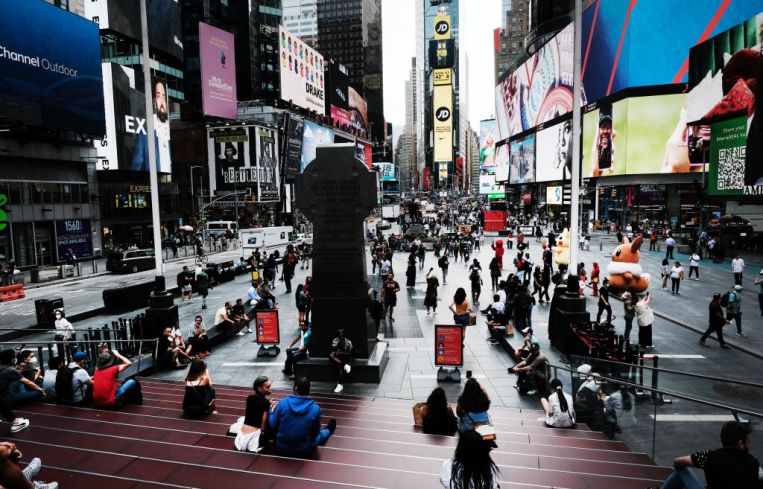NYC Sees Hospitality Job Gains in September as Hopes for Strong Holiday Season Grow
By Celia Young October 24, 2022 11:08 am
reprints
All New York City’s hospitality sector wants for Christmas is 2019, and it might finally get closer to its wish this year.
Gains in hospitality jobs helped drive unemployment in the city down from 6.6 percent in August to 5.6 percent in September, according to an Oct. 20 report from the New York State Department of Labor (DOL). The strong job numbers, coupled with growing hotel occupancy and a steadily increasing number of tourists flocking to the city, have sparked hope in the sector’s recovery for the crucial holiday season after it was walloped by the pandemic.
“There’s some headwinds that are still there, but there are a lot of positives to take from where we are,” Vijay Dandapani, president and CEO of trade organization the Hotel Association of New York City, said.
In New York state, the leisure and hospitality industries added 60,800 jobs in September, outpaced only by the education and health services sectors. Hospitality jobs increased by 10 percent year-over-year.
Overall job growth in the state has been overwhelmingly driven by New York City. While the state doesn’t break down sector job gains between the city and state, total unemployment in the rest of the state would have risen to 3.3 percent in September without the Big Apple’s jobs, according to the DOL.
Despite the improving job market, the hospitality industry is by no means counting its hotel rooms before they’re booked.
“It’s been a really tough two years and the revival essentially only started happening in March,” Dandapani said. “It’s been good, but the only caveat that I keep emphasizing is that we still have 17,000 hotel rooms that are closed.”
The loss of those hotel rooms could artificially inflate hotel occupancy numbers in the city, Dandapani said. While occupancy grew from 65.5 percent in September 2021 to 86.1 percent last month, the figure doesn’t take into account the city’s 90 closed hotels, painting an incomplete picture of the industry’s health, Dandapani said. Also, an additional 11,000 hotel rooms are expected to come online in the next three years, which could also impact occupancy rates, according to a report from the city’s tourism arm NYC & Company.
And even though occupancy rates are improving, revenue for the city’s hotel is expected to drop this year. A report from the American Hotel and Lodging Association estimated leisure travel revenue for hotels in the five boroughs would decline 4 percent by the end of 2022 compared to three years ago, which Dandapani blamed on the lack of international tourists. Business travel is expected to fare even worse and decline by 22 percent, the report found.
Still, Dandapani was optimistic that the city’s hotel industry would return to pre-pandemic occupancy levels by 2024 — bolstered by domestic tourists — and CBRE predicts that New York City will see an average occupancy of 78.2 percent in 2023.
Domestic tourism’s return, at least, is evident in Times Square. On Oct. 16, the crossroads of the world saw more than 370,000 visitors, 13 percent more than the number of visitors on the same day in 2019, according to a representative for business improvement district the Times Square Alliance. While Times Square has not consistently closed the gap between its 2019 and 2022 foot traffic, it saw 312,611 daily visitors on average in September, a 42.9 percent increase from last year and only about 17.3 percent below 2019 levels, according to the Alliance.
The hospitality sector’s comeback may be more significant this year given its slow recovery in 2021, said Elena Volovelsky, a labor market analysis for the New York City region at the DOL. Last December, hotel booking cancellations spiked globally, and at least a dozen New York City restaurants closed as the omicron variant spread and coronavirus cases skyrocketed during the crucial holiday tourism season. But Volovesky anticipated slightly smoother sailing this time around.
“If the trends that we’re seeing continue then I think it is reasonable to expect continued growth through the end of the year, barring some major turmoil,” Volovelsky said.
New York City’s restaurants have also seen a strong crop of visitors as of late, said Andrew Rigie, president of the trade group New York City Hospitality Alliance. He was hopeful that the city would avoid the catastrophe of last winter, though he remained concerned about the impacts of inflation and a looming recession on local businesses.
“Overall, we’re cautiously optimistic, but there’s still some real challenges for the industry,” Rigie said. “We don’t want to over-worry, but going into the holiday season last year we were optimistic, and then omicron struck and dealt another blow to the industry.”


